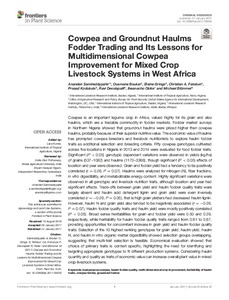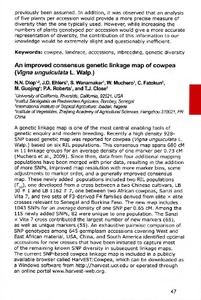| dc.contributor.author | Gumedzoe, M.Y. |
| dc.contributor.author | Rossel, H.W. |
| dc.contributor.author | Thottappilly, G. |
| dc.contributor.author | Asselin, A. |
| dc.contributor.author | Huguenot, C. |
| dc.date.accessioned | 2019-12-04T11:23:36Z |
| dc.date.available | 2019-12-04T11:23:36Z |
| dc.date.issued | 1998 |
| dc.identifier.citation | Gumedzoe, M.Y., Rossel, H.W., Thottappilly, G., Asselin, A. & Huguenot, C. (1998). Reaction of cowpea (Vigna unguiculata L. Walp.) to six isolates of blackeye cowpea mosaic virus (BlCMV) and cowpea aphid-borne mosaic virus (CAMV), two potyviruses infecting cowpea in Nigeria. International Journal of Pest Management, 44(1), 11-16. |
| dc.identifier.issn | 0967-0874 |
| dc.identifier.uri | https://hdl.handle.net/20.500.12478/4059 |
| dc.description.abstract | Five potyvirus isolates from various cowpea-producing areas (Guinea and Sudan savannas and forest zones) in Nigeria were identified by serology and infectivity tests as BlCMV (Isolates IT15, IT16 and WC) or as CAMV (isolates IT11 and ZARIA) and compared with the standard isolate of blackeye cowpea mosaic virus (BlCMV) (isolate ONNE) used at the International Institute of Tropical Agriculture (IITA) for screening purposes. According to the type and severity of symptoms on Nicotiana benthamiana and on selected susceptible cowpea cultivars, the BlCMV and CAMV isolates studied were grouped into three categories. Members of the first group (isolates IT15 and IT16) induced mild-to-severe bright yellow mosaic on selected susceptible cowpea cultivars and could not easily infect Nicotiana benthamiana, but the other two groups of isolates readily infected this plant. In the second group of isolates, ONNE and WC induced mosaic with variable severity in dark green and yellow patches. The third group (isolates IT11 and ZARIA) induced mild green mosaic and veinbanding symptoms on different cowpea lines. An evaluation of cowpea germplasm accessions and breeding lines using these BlCMV and CAMV isolates has shown that germplasm accessions TVu 401, TVu 1453 and TVu 1948 and breeding lines IT82D-885, IT82D-889 and IT82E-60 possess resistance genes to all six potyvirus isolates. These lines could be used in breeding programs at IITA to develop new cowpea varieties. |
| dc.description.sponsorship | International Development Research Centre |
| dc.language.iso | en |
| dc.subject | Vigna Unguiculata L. Walp. |
| dc.subject | Blackeye Cowpea |
| dc.subject | Mosaic Virus |
| dc.subject | Cowpea Aphid-Borne Mosaic Virus |
| dc.subject | Potyviruses |
| dc.title | Reaction of cowpea (Vigna unguiculata L. Walp.) to six isolates of blackeye cowpea mosaic virus (BlCMV) and cowpea aphidborne mosaic virus (CAMV), two potyviruses infecting cowpea in Nigeria |
| dc.type | Journal Article |
| dc.description.version | Peer Review |
| cg.contributor.affiliation | Université du Bénin |
| cg.contributor.affiliation | International Institute of Tropical Agriculture |
| cg.contributor.affiliation | Université Laval |
| cg.contributor.affiliation | Agriculture Canada Research Station |
| cg.coverage.region | Africa |
| cg.coverage.region | West Africa |
| cg.coverage.country | Nigeria |
| cg.isijournal | ISI Journal |
| cg.authorship.types | CGIAR and developing country institute |
| cg.iitasubject | Cowpea |
| cg.iitasubject | Plant Diseases |
| cg.iitasubject | Plant Breeding |
| cg.accessibilitystatus | Limited Access |
| local.dspaceid | 99345 |
| cg.identifier.doi | https://doi.org/10.1080/096708798228464 |



